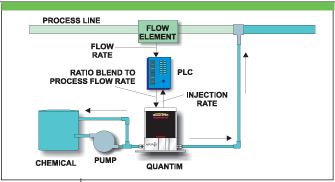|
Propane Odorant Injection |
Propane and other gaseous fuels are hazardous if leaks occur and are not detected, so odorant must be added to these fuels to allow the average nose to detect a leak before it becomes hazardous. Also, propane must be odorized before it can be transported. Failure of conventional odorization systems can result in delayed delivery of fuel at terminals and increased costs due to excess use of odorant to ensure that DOT requirements are met.
In most situations, ethyl mercaptan, the odorant used for propane, is injected into delivery vehicles at pipeline terminals where large inventories are maintained to service smaller distribution points. Positive displacement dosing pumps are used as the conventional dosing technology. Pump dosing is stroked as a function of a predetermined unit volume of propane delivered. The terminal control system stops delivery to the truck if two strokes of the pump do not occur. In this case, terminal deliveries are halted. To compensate, terminal operators typically over-inject 0.2 lbs of odorant per 10,000 gallons to make sure that the DOT requirement is met; however, no documentation of actual odorant delivery is created. Furthermore, the pump seals wear over time and require periodic maintenance.
THE BROOKS SOLUTION
Using a QUANTIM® mass flow controller (Model QMBC) to replace the positive displacement pump offers significant advantages. QUANTIM is an integrated mass flow controller with a Coriolis sensor, flow control valve and PID flow control electronics and software. Because it’s a mass flow product, the terminal control system can determine exactly how much odorant must be added in lbs/min based on propane delivery. QUANTIM provides continuous odorant delivery proportional to gas flow rate at the injection point. It has no moving parts, so it’s extremely reliable, and it provides an analog feedback signal to the terminal’s SCADA system of the actual material injection rate, so there’s never any need to over-inject odorant. In addition, QUANTIM can deliver an alarm to the terminal operator of any abnormal operating conditions.

The result is more reliable terminal operations, no downtime due to periodic maintenance, a reduction of odorant usage, complete documentation of odorant delivery, and a short payback timeframe.
|



